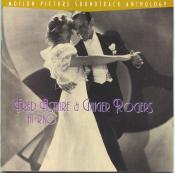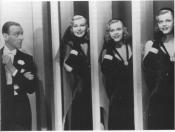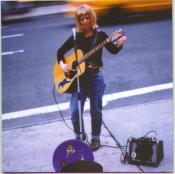 Fred Astaire
& Ginger Rogers at RKO (Rhino 1998) - Though they starred together on the
silver screen for only six years, Fred Astaire and Ginger Rogers remain the greatest
dancing duo in film history. On Astaire & Rogers at RKO, 35
recordings have been gathered from eight films made between 1933 and 1938.
Fred Astaire
& Ginger Rogers at RKO (Rhino 1998) - Though they starred together on the
silver screen for only six years, Fred Astaire and Ginger Rogers remain the greatest
dancing duo in film history. On Astaire & Rogers at RKO, 35
recordings have been gathered from eight films made between 1933 and 1938.And what films they were, including "Top Hat" (1935), "Swing Time" (1936), "Shall We Dance?" (1937), and "Carefree" (1938). In addition to their dancing talents, Fred and Ginger were talented singers: In fact, many top songwriters (such as Johnny Mercer, George & Ira Gershwin, Jerome Kern, and Irving Berlin) sought out Fred to record their material.
Astaire and Rogers met in the early 1930s in New York, where he was already an established star of Vaudeville and Broadway, while Ginger was an up-and-coming actress eleven years his junior. Paired together first in 1933's "Flying Down to Rio," the pair came to symbolize grace and sophistication for generations of moviegoers.
The tracks on Astaire & Rogers at RKO are taken directly from the film soundtracks, and include such classic numbers of "A Foggy Day," "Night and Day," and "The Way You Look Tonight." Also included are eight tracks from the films that have not previously been released on disk or album.
 Which brings up this point. Fred
was a hugely popular performer, who had a radio show, successful nightclub engagements and
many records.
Which brings up this point. Fred
was a hugely popular performer, who had a radio show, successful nightclub engagements and
many records.
Because they are taken directly from the films, the songs on At RKO have a "movieish" feel, with heavy orchestration and abbreviated arrangements, which were then followed by the classic dance numbers.
By contrast, Columbia Records released Starring Fred Astaire nearly ten years ago, which drew from radio recordings and 78's of the same songs performed by Fred with a more intimate studio accompaniment. For my taste, the studio versions do better justice to the songs.
On the other hand, nothing can match the incomparable grace and flair of the films, where the movie versions of the songs sparkle.
I've seen the Astaire and Rogers films more than 50 times, and enjoyed Astaire & Rogers at RKO as a reminder of the movies. But you have to remember that these tracks are drawn from the movies and were intended to be presented in the context of the big screen. If you want more of Fred as a vocalist, look for his studio recordings.
 Mary Lou Lord, Got No
Shadow (Work 1998) - Former Boston busker Mary Lou Lord inspired a heated bidding
war several years ago in the music business. With her major label debut, Got No
Shadow, Lord displays an easygoing and intimate approach.
Mary Lou Lord, Got No
Shadow (Work 1998) - Former Boston busker Mary Lou Lord inspired a heated bidding
war several years ago in the music business. With her major label debut, Got No
Shadow, Lord displays an easygoing and intimate approach.
Lord grew up in Massachusetts as the youngest of five children. After a stint at Boston's Berklee School of Music, she became a tireless street performer in Harvard Square and at subway stops throughout Boston and Cambridge, selling homemade tapes and playing on street corners.
Thanks to a chance meeting, Lord hooked up with Kill Rock Stars, a Seattle-based label that has generated such acts as Bikini Kill and Sleater-Kinney. Lord relocated to the Pacific Northwest for a time, where she discovered that it was possible to mix grunge with folk.
After reaching a new level, Mary Lou drew six-figure offers from the major labels. Recalls Mary Lou, "It was really scary. Because I knew I wasn't ready. So I kept putting them off." Instead, Mary Lou signed as a songwriter to develop her skills, and recorded a couple of indie releases for KRS, including the EP, Martian Saints.
Got No Shadow shows Mary Lou to be an accomplished, if understated, singer. Songs on the album include "Some Jingle Jangle Morning" and "Western Union Desperate." Mary Lou's street roots remain close on such tracks as "Subway."
Worth the wait? It's hard to say. But Mary Lou has a strong sense of herself.
- Randy Krbechek © 1998
Check CD Shakedown for Weekly
Reviews of Music CDs and New Albums ( www.cdshakedown.com
)